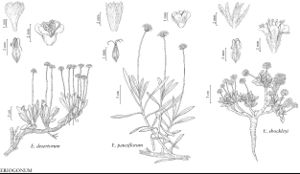Eriogonum desertorum
Fl. Idaho, 246. 1952.
Herbs, matted, scapose, 0.5–1.2 × 0.7–4 dm, tomentose or floccose, grayish. Stems spreading, with persistent leaf bases, up to 1/5 height of plant; caudex stems matted; aerial flowering stems scapelike, erect, slender, solid, not fistulose, (0.2–)0.4–1 dm, tomentose or floccose. Leaves basal, fasciculate in terminal tufts; petiole 0.3–1.5 cm, tomentose to floccose; blade oblanceolate to elliptic or, rarely, ovate, 0.4–2(–2.5) × 0.2–1 cm, densely greenish- or grayish-white-tomentose on both surfaces or densely greenish-white tomentose abaxially, margins plane. Inflorescences capitate, 0.7–1.5 cm; branches absent; bracts 3, scalelike, triangular, 1.5–2 mm. Peduncles absent. Involucres 4–7(–9) per cluster, turbinate to turbinate-campanulate, 2–3.5 × 2–3.5 mm, weakly rigid, floccose at least on teeth; teeth 5–8, erect. Flowers 2–3.5 mm; perianth yellow, glabrous; tepals connate proximal 1/4–1/3, monomorphic, lanceolate or oblong; stamens exserted, 2–4 mm; filaments glabrous or sparsely pilose proximally. Achenes brown, 2–3.5 mm, glabrous or sometimes with minute bristles on beak.
Phenology: Flowering May–Aug.
Habitat: Gravelly or silty to clayey flats, slopes, and ridges, often on limestone soils, mixed grassland, saltbush, and sagebrush communities, pinyon-juniper woodlands
Elevation: 1500-3000 m
Discussion
Eriogonum desertorum is a low- to mid-elevation species restricted to central and eastern Elko County, Nevada, and northwestern Box Elder County, Utah. The phase represented by the type is from the valley bottoms and lower foothills, although it extends onto the eastern slope of the East Humboldt Mountains to ca. 2600 m elevation. Such plants tend to have leaf blades that are grayish-tomentose on both surfaces. At higher elevations on isolated desert ranges (Jarbidge, Independent, and Kinsley mountains, where they occur as low as 1950 m) are plants that are smaller in all aspects and tend to have elliptic (rather than oblanceolate to narrowly elliptic) leaf blades; these have been named E. lewisii. Similar plants are in the Grouse Creek Mountains of Utah. As noted above, E. brevicaule var. bannockense occurs in eastern Elko County, where it is widespread and more common than E. desertorum. It is almost always at low elevations in the valley bottoms but can occur on some of the higher, isolated peaks. The leaf blades of var. bannockense are distinctly narrower and mostly longer.
Selected References
None.

